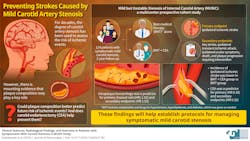Current risk assessment guidelines for ischemic stroke may underestimate patients with mild carotid stenosis. A Japanese multicenter study found that unstable plaque—particularly intraplaque hemorrhage—was a key stroke predictor.
Surgical intervention, such as carotid endarterectomy, significantly reduced stroke risk compared to medical therapy alone. These findings could prompt a shift in how physicians assess and treat mild but symptomatic carotid artery disease.
Despite being classified as ‘low-risk’ due to having less than 50% carotid artery narrowing, a significant number of patients with mild carotid stenosis continue to experience recurrent ischemic events, even when receiving appropriate medical therapy. This implies that factors beyond the degree of stenosis may play a crucial role in determining stroke risk for this patient population.
A team including Lecturer Daina Kashiwazaki and Dr. Satoshi Kuroda from Toyama University, Japan, aimed to tackle this knowledge gap via their ‘Mild but Unstable Stenosis of Internal Carotid Artery (MUSIC)’ study. This multicenter prospective cohort study, which was published online on February 21, 2025, in the Journal of Neurosurgery, investigated the clinical features, radiological findings, and treatment outcomes of patients with symptomatic mild carotid stenosis.
The researchers enrolled 124 patients who had experienced cerebrovascular or retinal ischemic events ipsilateral (same side) to mild carotid stenosis. While all participants received the best medical therapy (BMT) for their condition, carotid endarterectomy (CEA)—the surgical removal of plaque—or carotid artery stenting (CAS) was performed in 63 patients. Patients were followed for two years, with the primary endpoint being the occurrence of ipsilateral ischemic stroke.
The findings: approximately 81% of patients had radiologically unstable plaque, with 59.5% exhibiting intraplaque hemorrhage (IPH). This type of plaque composition was associated with a significantly higher risk of both primary and secondary endpoints, the latter of which included ocular symptoms, any type of stroke, and plaque progression requiring CEA. Additionally, the incidence of ipsilateral ischemic stroke was markedly higher in the group receiving only BMT compared to those who also underwent CEA (15.1% vs. 1.7%).
The results demonstrated that CEA significantly reduced the incidence of both primary and secondary endpoints during the two-year follow-up period, with CEA emerging as a protective factor and IPH as a risk factor for recurrent events.

